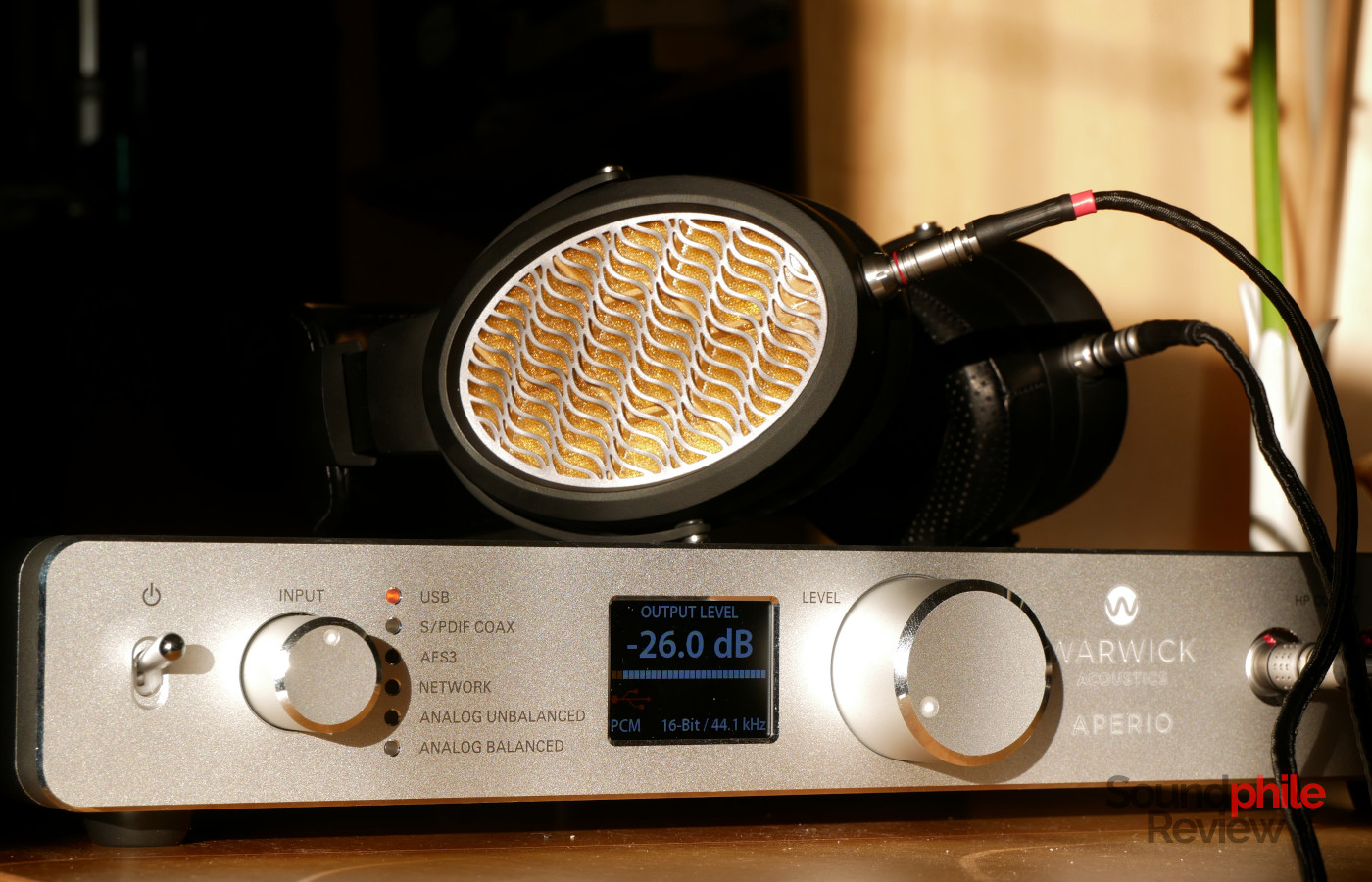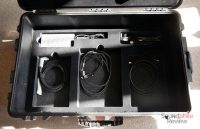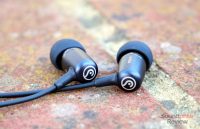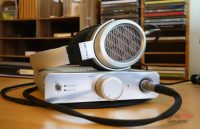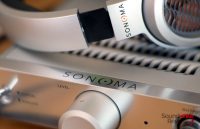You don’t see £20,000 all at once everyday and even more rarely you see them in the form of headphones. I’ve been quite worried seeing the Warwick Acoustics APERIO headphone system on my desk because of their price, but then those worries evaporated when I put on the headphones and played some music with them. The Warwick Acoustics APERIO stands out not just because it is one of the most expensive headphones systems in the world, but also because of its remarkable ability of reproducing music with a highly technical approach. It is even more remarkable as it is just the second product of this British start-up: it’s not common to see a company shoot for the stars and reach them, but Warwick Acoustics definitely did with the APERIO.
Disclaimer: Warwick Acoustics kindly loaned this unit to me for a rather long period (thank you, Martin!). Additional information is available on their website.
TL;DR: recap
| Pros |
Cons |
| Refined design and build
Very comfortable Extremely detailed and highly dynamic
|
Little soundstage depth
Few can afford it |
Rating: 10/10
Packaging & Accessories
The APERIO system comes in a trunk large enough that I could almost hide in there (and I’m a 176 cm, 70 kg adult!). In this massive crate are the headphones, the DAC/amp/energiser unit, the headphone cable, a USB cable, a custom Ethernet cable and the power supply unit. Everything is stored in abundant padding, which constitutes the bulk of the >20 kg weight of the box.
Both cables present outstanding build quality. They use SF/FTP construction, which means there are an overall screen and an overall foil with foil-screened twisted pairs – in other words, there is both an overall shielding (an aluminium-Mylar foil plus a copper-plated Aramid fibre braiding) and a shielding of each individual double-helix twisted pair conductor. Each conductor is in turn made with 66 strands of OFHC copper plated in silver.
The USB cable is compliant with the USB 2.0 standard and Warwick Acoustics claims it maintains an optimal 90 Ω impedance over the whole length to keep noise and interference to a minimum.
The Ethernet cable has a custom termination on the DAC part: it has a surrounding metal structure that’s identical to that of XLR cables, so it’s actually much more reinforced and resistant than normal Ethernet cables. Any network cable can be used, but this one has superior quality components: the plugs are Cat 6A certified, while the cable itself has a Cat 7 certification.
Warwick Acoustics APERIO Headphones Design & Comfort

The Warwick Acoustics APERIO headphones look quite unique and appear refined and rich. The mix of the various materials is done masterfully so that the APERIO headphones look like they are an object crafted by an artisan, a work of art instead of a device that serves an active purpose. Warwick Acoustics managed to create a design that’s refined and polished, something that clearly looks high-end, with a class that’s unique. That’s probably the word I would use for design of the APERIO: classy.
The ear cups are made using injected magnesium as the company claims this material is “lighter and significantly better-damped than aluminium and most polymers”. Structural fasteners are made from stainless steel, while gaskets are obtained using closed-cell foams. The ear cushions (or earpads, if you prefer) are covered with sustainably-sourced top-grain Cabretta leather – my vegetarian soul protests, but admits that it does serve its purpose incredibly well. Thanks to this mix of materials, the headphones not only look high-end, but also feel so to the touch.

I mentioned the leather material used for the earpads previously: that serves a purpose in terms of sealing as well, as the reproduction of low frequencies requires the air inside the earcups to be sealed and the leather does exactly that. The inner perimeter of the ear cushions features foam that is acoustically absorbent in order to prevent reflections and refractions inside the earcups. The leather that actually comes into contact with the head is perforated to help with heat dissipation, helped in that by a woven copper thread (and this is the first time I hear of such a solution being used).
The Warwick Acoustics APERIO headphones appear to be quite large and heavy, something that only people with very large heads could find comfortable. The truth could not be farther from this, because despite being large and relatively heavy, at 406 g, I found the APERIO headphones to be extremely comfortable. They have very generous amounts of padding that make even my extremely sensitive scalp happy wearing them. I can wear the APERIO for more than four hours and barely notice it, which means that “normal” people should be able to wear them endlessly. That’s also thanks to the relatively strong clamping force of the earcups, which are very well padded and therefore prevent any fatigue from building up during listening sessions.

Speaking of the clamp, Warwick Acoustics states that they designed the headband looking at a number of head sizes and found “the optimum clamping force to ensure a good air seal and stability on the head, without excessive pressure that could be problematic during long listening sessions”. They indeed managed to make that happen as, despite wearing glasses, I never found the clamping force to be excessive or to cause fatigue.
Lastly, one of the worries stemming from electrostatic headphones is their use of high voltage in order to work. To this regard Warwick Acoustics states that “the BD-HPEL transducer is electrically isolated from the conductive magnesium components. The headphone body is electrically grounded and features double-insulated electrical connections; internal wiring is insulated with High Voltage Silicone and Teflon. High performance, polarised, self-latching, stainless steel connectors with gold-plated copper, multipole contacts are utilised for electrical connection to the headphone cable.”
The cable is thick: it is roughly 1 cm in width and 0.5 cm in thickness – it is not round, but flattened. It is detachable from both the headphones and the amplifier, with security latches that prevent it from accidentally coming out of the sockets. It’s robust and seemingly durable, but it’s also not really soft and the flattened shape makes it often difficult to bend it. It’s also quite heavy and this might be an issue with comfort if one doesn’t use the APERIO at the desk but, as an example, on the sofa (something you can do, as the cable is 2 metres long).
APERIO Energiser Features & Specs
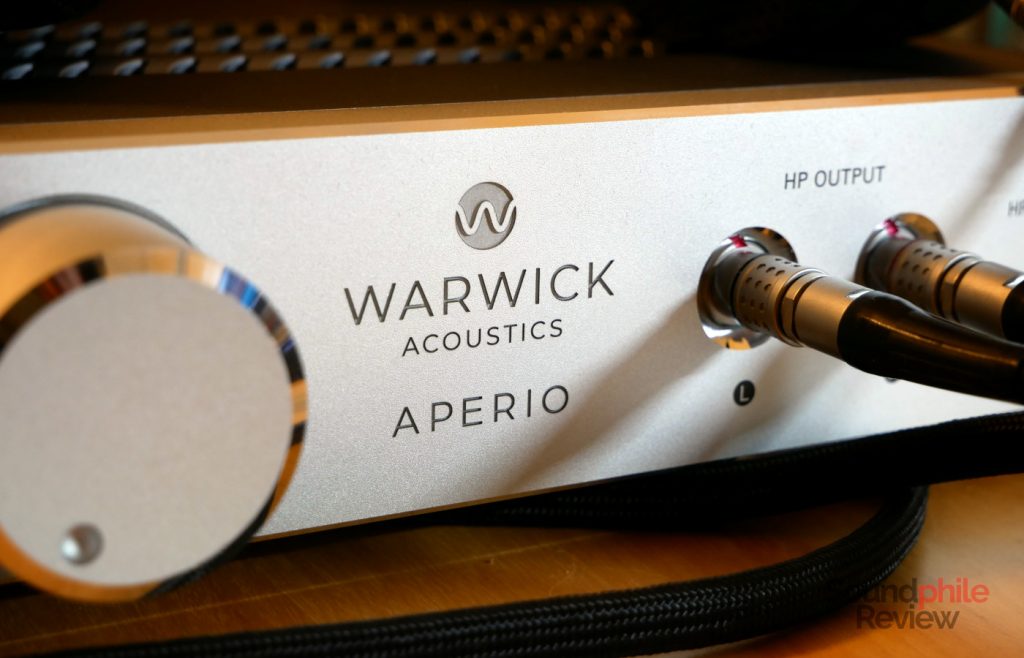
The Warwick Acoustics APERIO is a complete system and as such the main unit works as a DAC, amplifier, energiser and network player (through Roon). Due to this it offers quite a vast amount of inputs and outputs. On the digital input front we find USB, Ethernet, coaxial and AES (no Bluetooth!), while the analogue offers RCA and XLR. Outputs include headphones (with dual proprietary connectors), RCA and XLR.
The unit is 413 x 351 x 68 mm, which is in line with the size you usually see associated to CD players, integrated amplifiers and other large electronics – not headphone amplifiers. The reason for this very large size (and associated weight: 7.4 kg without power supply!) is that the chassis is made of thick machined aluminium and contains a fully balanced (or dual-differential) setup which requires duplication of many components.
The design is quite similar to that of the Warwick Acoustics Sonoma M1 main unit: it is made of six pieces of machined aluminium (one per side), with the most notable difference being the input selector and the screen on the front. The screen is used to deliver information on the currently-used inputs and output, as well as sampling rate of media playing and volume. It can also show if there are any issues with the components inside thanks to an auto-diagnose feature.

The volume knob offers volume adjustment based on discrete steps instead of a continuous adjustment. It has some weight to it which makes selecting the right volume step easy.
Seeing how the unit comes with a 200 W power supply unit, I was worried about power consumption so I asked Martin Roberts about how line out mode is managed. While it is understandable that full power is drawn when the headphones are reproducing music, I was wondering whether the energiser stage that provides bias voltage to the headphones would shut down when the “line out” mode is selected. Martin confirmed to me that this is the case, so power consumption should be significantly inferior when using the main unit as a DAC only.
Speaking of power, the unit becomes quite warm to the touch; it’s enough to feel it but it never becomes uncomfortably hot. People living in hotter areas where the temperatures rise over 35 °C might want to point a fan at it, though.
The APERIO is plug-and-play on Linux and macOS, but it requires specialised drivers on Windows.
Warwick Acoustics APERIO DAC & Amp |
| Input | USB (up to 32 bit / 384 kHz PCM, DSD256 both DoP and native) Coaxial AES (up to 24 bit / 192 kHz PCM) Network (RJ45; up to 32 bit / 384 kHz PCM, DSD256 both DoP and native) RCA XLR |
| Suitable headphones impedance | N/A |
| Output impedance | N/A |
| Maximum output power | N/A |
| Frequency response | N/A |
| THD+N (@1 kHz) | < 0.001% |
| SNR | N/A |
| Crosstalk | N/A |
There is not a lot of information available on the technical details of the main unit: Warwick Acoustics does not declare what kind of DAC it uses (Warwick only says “2 x dual mono, 32-bit / 384 kHz DACs with balanced outputs”) and the only thing we know is that the design is balanced for the entirety of the signal path. The amplifier is solid-state with discrete MOSFET components, with a bias voltage of 1,800 V.
As the Sonoma M1 had a DSP managing sound even when it came to analogue inputs, I asked Martin whether that applied to the APERIO as well. He told me that the APERIO has a purely analogue signal path which is even used to help with the DSD file processing in order to avoid latency.
Sound & Headphones Specs
I listened to a variety of music, mostly FLACs ripped from CDs (and therefore in 16 bit / 44.1 kHz resolution), with the APERIO connected to my notebook.
Warwick Acoustics APERIO |
| Frequency response | 10 – 60,000 Hz |
| Impedance | N/A |
| Sensitivity | N/A |
The APERIO headphones changed since I heard them six months ago in Ascot at the UK Hi-Fi Show Live!. The nice people over at Warwick Acoustics made some production refinements to the transducer that adds bass presence and places less emphasis on midrange and treble. This brings more balance to the tuning of the APERIO while leaving what impressed me about them untouched – the result is an awesome blend of technicalities and just pure auditive pleasure.
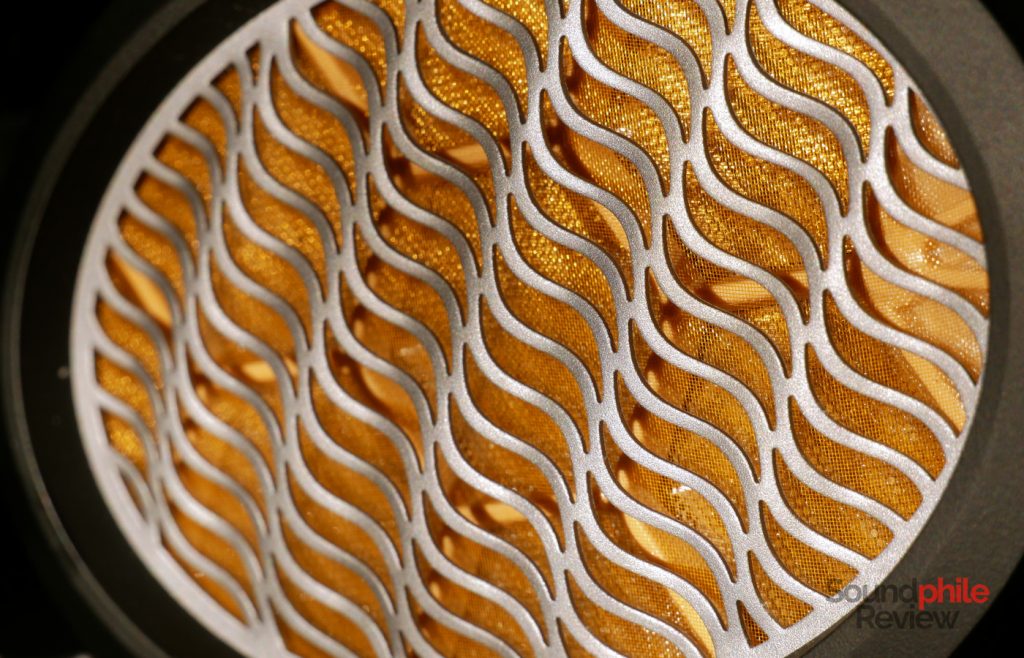
Whereas the Sonoma M1 made a technological statement on top of a tuning one, as they used a single-sided stator instead of the usual approach that uses two, the APERIO uses a more traditional approach to this matter as it uses a BD-HPEL (an acronym which stands for Balanced-Drive High Precision Electrostatic Laminate), which is a laminate with one stator on each side. This may in fact be called an evolution over the HPEL transducer that characterised the Sonoma M1, one that is mainly set apart by the presence of a symmetric drive. The advantage of this design over the previous one is that the 3,570 mm² laminate can now move twice as much, increasing physicality, improving linearity and lowering distortion.
One of the reasons people have wanted to create music reproduction systems is to recreate the feeling of being present during the live performance, of being able to recreate the sensations and emotions that they give us. What we really want is not to hear headphones and speakers, but the instruments. I’ve used the APERIO for two weeks as I’m writing the lines in this paragraph and I have to say that – in what is a pleasant surprise and an exception to the rule – this system has been able to consistently wow me and make me forget I was wearing headphones. The breadth and depth of the stage, the level of detail, the immediacy of sound all concur in making me feel as if I wasn’t wearing anything. The only thing that brings me back to reality is my scalp, which hurts due to the weight of the headphones after a long listening session – but that’s just my specific case due to my hyper-irritable scalp, because the APERIO do all that’s possible to say “hey, we’re not even here, forget about us”. And I think this is the best and greatest achievement a headphone system can ever get, it’s the ultimate goal and the raison d’etre of headphones, while also being the Holy Grail – the thing you will search forever, without ever finding it – of audiophiles. Yet the APERIO get as close to that as headphones currently can. It’s fun how the ultimate goal of something is to basically not be there, isn’t it?
The music is presented on an expansive stage which extends far on the left and on the right, but not as far in terms of depth. Even putting headphones on at a slight angle the stage only gains a hint of depth, but it does not give the listener the impression of the music playing in a large concert hall. Not that this is a bad thing, as it actually makes music sound more intimate and directly in touch with the listener. What I love about the APERIO is that the sounds have incredibly precise spatial locations. When you hear a “real” sound, one made by objects or people around you, you can often point to its location with a good level of accuracy; this is a difficult task to achieve when you use headphones: depending on the recording techniques used, on the mixing and on the headphones themselves, sounds may not conserve the spatial information that they originally had. As most mixes are done using speakers, it’s then difficult to recreate the same sense of space the authors (or at least the mixing engineer) intended using headphones. It’s all the more impressive then that the APERIO have such accurate placements of instruments and they’re able to give each instrument a position in space which does not overlap with others.
That also brings instrument separation in the discourse. The APERIO achieve an amazing level of separation between the various parts, so much so that each instrument appears to almost being playing on its own and independently of others. The level of detail of each instrument even in complex tracks is such that I’m not afraid to claim that it’s easier to spot details in recordings when listening to them on the APERIO than when listening to the real thing. Let’s be honest: live music gives you a whole host of details that, depending on the venue, might be a bit mish-mashed. The APERIO bring you a sound that in this sense is more real than the real thing.
And that might be an issue. Several weeks ago I was speaking with an acquaintance of mine who’s a composer and we were discussing of how high-end headphones allow you to hear even the smallest details, when he asked me: “do you think that they heard that when they mixed the track? Did they want you to hear that?”. That’s an interesting point of view and one I’d never considered before. Surely the APERIO shows more than most tracks should in their creator’s eyes and this might also mean that you realise recordings you liked are actually not that great in terms of quality. That’s the other side of the coin of audiophilia, I guess.
But honestly speaking I’ve never had much trouble with that during my time with the Warwick Acoustics APERIO. Even stereotypically – and intentionally – bad recordings such as black metal ones actually sounded quite great. If anything, the APERIO made me realise how much good music there is out there and how complex and filled with details and information it is. If anything, the APERIO made me love music more, instead of less, even when it displayed the shortcomings of the recordings or mixes (one such example is Philthy’s Party Crashers: I could tell that the mix was done on speakers or headphones which had prominent bass, because the tracks lack it and sound more natural when adding more bass through equalisation).
Now, the Warwick Acoustics APERIO is not perfectly neutral. I don’t think that was its creators’ aim, either; because let’s be honest: what is neutral anyway? There are countless definitions and my personal one (the closest reproduction of the real, live-performed music) might not be the most widely accepted nor the one you would actually want. This is an endless debate among audiophiles and I don’t really want to stir it here; what I want to say is that the APERIO targets a curve that emphasises bass and lower midrange a little while adding a bit additional presence to upper midrange and lower treble as well so that it gives a slightly more central role to high-pitched instruments. It’s almost analytical in its presentation, but not in the sense that it sounds cold or “distant”, as on the contrary it sounds lively, engaging, fun and entertaining.
What contributes to this is the fact that bass goes deep – 20 Hz deep – and transients are blazing fast (that’s a highly technical term there). The overall result is that music comes alive and draws you in. You’re not listening to the headphones anymore, you are left alone with the music.
Final Thoughts
There are few headphones that push the limits of what is possible to achieve like the Warwick Acoustics APERIO does. Not only is it a great achievement from an engineering point of view, but an achievement that also brings great sound quality with it. Thinking that this is only the second product that Warwick Acoustics created seems impossible, but the company has aimed high and succeeded in its efforts.
Tonally speaking the APERIO is not perfect – nothing in this world is – but the way the music is portrayed makes the headphones sound almost as if they were an instrument themselves and not just a reproduction system. One of the thoughts I have been toying with lately is that technology is only interesting when it serves a purpose and not in and by itself and I find this fits in perfectly with the APERIO: the technologies applied to its design and manufacturing become interesting specifically because they serve the purpose of reproducing music in the best possible way.
It is not a matter of debate that the Warwick Acoustics APERIO is among the best-sounding headphones systems in the world. Independently of the price, the APERIO is probably the ultimate audio device – a testament to how far our pursuit for good sound has come and a headphone system that will be relevant even in twenty years. If you are so lucky that you have pockets deep enough you can afford the APERIO, you are in for a very big treat, one that will give you almost endless pleasure.
In loving memory of my grandfather, the kindest person I’ve ever met and the person who introduced me to audiophilia, among so many other things. The fond memory of our conversations on audio and good food will always be with me.

